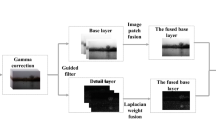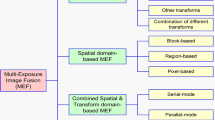Abstract
Bad weather conditions such as fog, haze, etc. reduce the visibility level of the images captured in those weather conditions. Degradation of visibility in the captured images is a serious concern nowadays. Even though there are many different devices available for dehazing several devices lack the capability of efficient dehazing, and they are not capable of effectively mitigating the visibility degradation caused by those unusual weather conditions. The image processing task which is concerned with this phenomenon is called image dehazing. In this article, an image fusion-based approach is proposed which eliminates the usage of depth information thus the need for depth calculation is avoided in this method which is a tedious process. This proposed method thus enhances the performance and robustness of the image dehazing process. To achieve this goal the hazy images, undergo a set of gamma corrections operations followed by the fusion of various Gamma-corrected underexposed images obtained from the gamma correction operation followed by color saturation adjustment thus yielding an image with better visibility which is nowadays a major concern as many devices require images with higher quality for processing. Fusion of underexposed images obtained by artificial methods can remove the haze effectively when the situations are challenging. Other image dehazing techniques tend to fail and the proposed method helps to produce better results in terms of PSNR, SSIM, Entropy, accumulation and running time.





Similar content being viewed by others
Data availability
Data sharing not applicable to this article as no datasets were generated or analyzed during the current study.
References
Fazlali H, Shirani S, McDonald M et al (2020) Aerial image dehazing using a deep convolutional autoencoder. Multimed Tools Appl 79:29493–29511. https://doi.org/10.1007/s11042-020-09383-7
Galdran A (2018) Image dehazing by artificial multiple-exposure image fusion. Signal Process 149:135–147
He K, Sun J, Tang X (2009) Single image haze removal using dark channel prior. In: Proc. IEEE Conf. Comput. Vis. Pattern Recognit., pp 1956–1963
Hore A, Ziou D (2010) Image quality metrics: PSNR vs. SSIM. In: Proc. 20th Int. Conf. Pattern Recognit., pp 2366–2369
Huang J, Jiang W, Li L et al (2019) DeeptransMap: a considerably deep transmission estimation network for single image dehazing. Multimed Tools Appl 78:30627–30649. https://doi.org/10.1007/s11042-018-6536-x
Lakshmi T, Reddy CK, Padmavathi K et al (2022) Entropy based single image dehazing with refined transmission using holistic edges. Multimed Tools Appl 81:20229–20253. https://doi.org/10.1007/s11042-022-12485-z
Liu Y, Jia P, Zhou H et al (2022) Joint dehazing and denoising for single nighttime image via multi-scale decomposition. Multimed Tools Appl 81:23941–23962. https://doi.org/10.1007/s11042-022-12681-x
Raikwar SC, Tapaswi S (2020) Adaptive dehazing control factor based fast single image dehazing. Multimed Tools Appl 79:891–918. https://doi.org/10.1007/s11042-019-08120-z
Verma P, Srivastava R (2020) Three stage deep network for 3D human pose reconstruction by exploiting spatial and temporal data via its 2D pose. J Vis Commun Image Represent 71:102866
Verma P, Srivastava R (2022) Two-stage multi-view deep network for 3D human pose reconstruction using images and its 2D joint heatmaps through enhanced stack-hourglass approach. Vis Comput 38:2417–2430. https://doi.org/10.1007/s00371-021-02120-7
Wang Z, Bovik AC, Sheikh HR, Simoncelli EP (2004) Image quality assessment: from error visibility to structural similarity. IEEE Trans Image Process 13(4):600–612
Wang Y, Yin S, Basu A (2021) A multi-scale attentive recurrent network for image dehazing. Multimed Tools Appl 80:32539–32565. https://doi.org/10.1007/s11042-021-11209-z
Yao T, Liang Y, Zhang L et al (2022) Single image dehazing via cycle-consistent adversarial networks with a multi-scale hybrid encoder-decoder and global correlation loss. Multimed Tools Appl. https://doi.org/10.1007/s11042-022-13772-5
Zhu Q, Mai J, Shao L (2015) A fast single image haze removal algorithm using color attenuation prior. IEEE Trans Image Process 24(11):3522–3533
Zhu Z, Wei H, Hu G, Li Y, Qi G, Mazur N (2021) A novel fast single image dehazing algorithm based on artificial multiexposure image fusion. In: IEEE Transactions on Instrumentation and Measurement, vol 70, pp 1–23, Art no 5001523. https://doi.org/10.1109/TIM.2020.3024335
Author information
Authors and Affiliations
Corresponding author
Ethics declarations
Conflict of interest
The authors have no conflicts of interest to declare that are relevant to the content of this article.
Additional information
Publisher’s note
Springer Nature remains neutral with regard to jurisdictional claims in published maps and institutional affiliations.
Rights and permissions
Springer Nature or its licensor (e.g. a society or other partner) holds exclusive rights to this article under a publishing agreement with the author(s) or other rightsholder(s); author self-archiving of the accepted manuscript version of this article is solely governed by the terms of such publishing agreement and applicable law.
About this article
Cite this article
Rajasekaran, G., Abitha, V. & Vaishnavi, S.M. Image dehazing algorithm based on artificial multi-exposure image fusion. Multimed Tools Appl 82, 41241–41251 (2023). https://doi.org/10.1007/s11042-023-15210-6
Received:
Revised:
Accepted:
Published:
Issue Date:
DOI: https://doi.org/10.1007/s11042-023-15210-6




